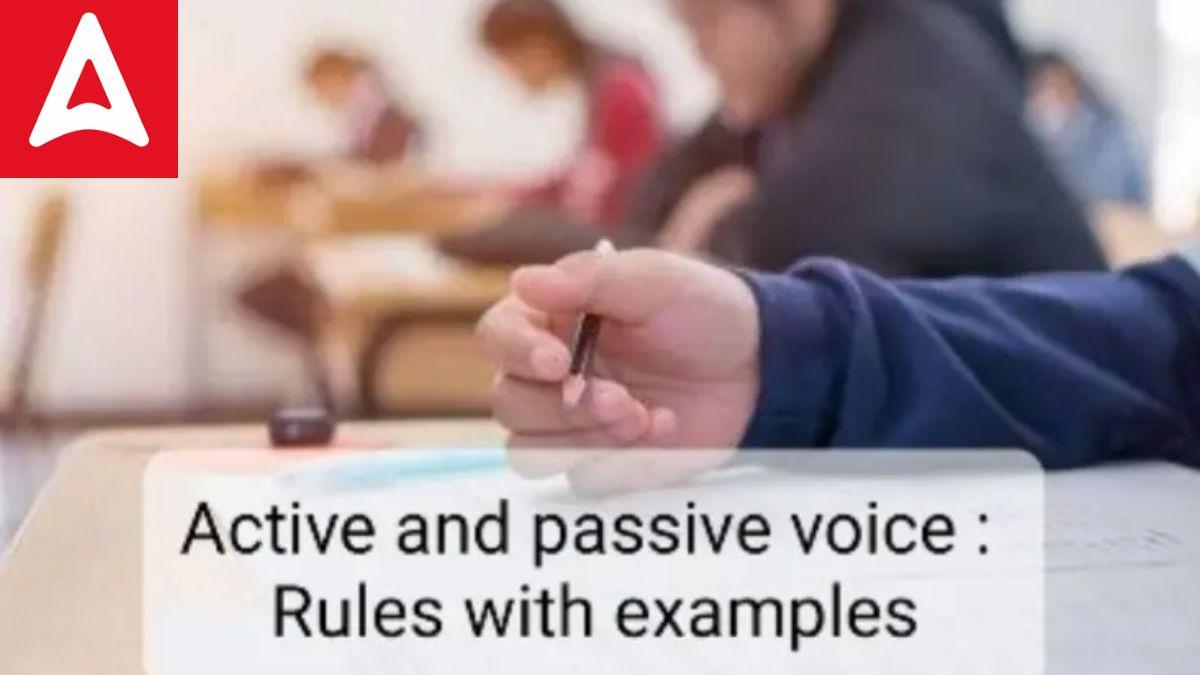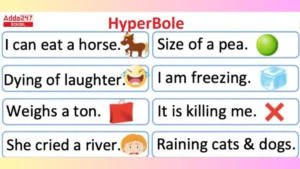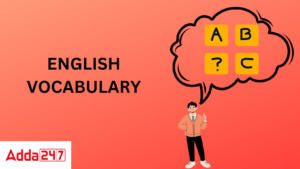Table of Contents
The active voice is a grammatical voice in which the subject of the sentence executes the verb’s action. For example, in the sentence “The dog chased the ball,” the subject “dog” is doing the action “chased.” The passive voice is a grammatical voice in which the subject of the sentence receives the verb’s action. For example, in the sentence “The ball was chased by the dog,” the subject “ball” receives the action “chased.”
The major distinction between active and passive voice is the focus of the phrase. The emphasis in active voice is on the topic and the action they are performing. The emphasis in passive voice is on the object of the activity and the person or thing doing the action.
Active and Passive Voice
Active and Passive voice: In English grammar, Active and passive voice is one of the fundamental applications of forms of verbs. Active voice is a sentence that starts with a subject or ‘ doer ‘ and passive voice is a sentence that begins with the object. Before we learn about Active voice and passive voice, first we understand about voice. In this article, we understand active and passive voice and its sentence structure with examples. Here we provide a list of 20 Active and Passive voice change questions for practice.
Active and Passive Voice Examples with Answers
The term Voice is used to denote the form of a verb that shows whether a grammatical subject is doing the action or receiving it. Voices are categorized into 2 classes-
Active Voice – In sentences written in the active voice, the subject takes part in the action.
Passive Voice– in passive voice sentences, the subject is the recipient of the action.
In academic writing, it is typically preferred to use an active verb along with a subject that specifically identifies the person or thing doing the action. Verbs in the active voice are more powerful and typically forceful than verbs in the passive voice or versions of the verb “be.”
Example –
Active voice – I teach English
Passive voice – English is taught by me.
Here, In the active voice, the sentence starts with the subject ( the teacher) But In a passive voice, the sentence begins with the object (the boy).
Rules of Active and Passive Voice Sentence Structure
Now, we must understand the formation of sentences in active and passive voice. We know that Active voice starts with the subject or pronoun, whereas passive voice starts with the object. let’s understand the structure of active and passive voice with examples.
Active voice Structure – Subject+verb+object
Eg- I teach mathematics.
I wrote the letter.
Passive voice Structure– Object -verb – subject
Eg- Mathematics is taught by me.
The letter was written by me.
Active and Passive Voice- Forms of verbs
Let’s see different types of passive voice and active voice one by one and their Structures. Before when knowing about various rules about voice, first understand those three forms of verbs. Those are- 1) Present form of the verb ( V¹ )
2) past form of the verb (V²)
3) Past participle form of the verb (V³)
Let’s understand with some examples of verbs.
| The basic form of the verb | The present form of the verb ( V¹ ) | The past form of the verb (V²) | Past participle form of the verb (V³) |
| Be | Be | was, were | been |
| See | See | Saw | Seen |
| Fly | Fly | Flew | Flown |
| Become | Become | Became | Become |
| Rise | Rise | Rose | Risen |
| Dig | Dig | Dug | Dug |
| Eat | Eat | Ate | Eaten |
| Go | Go | Went | Gone |
Active and Passive Voice Rules- Change in pronoun
when we change an active voice into a passive voice, we have to change the pronoun into an objective form or vice versa. For example.
Active form-I helped them
passive from-They were helped by me.
Here is a list of some important pronouns with their subjective form as well as objective forms.
| Subject form | object form |
| He | Him |
| She | Her |
| It | It |
| I | Me |
| We | Us |
| They | Them |
| You | You |
Active to Passive Voice Change Rules
Simple present tense –
Active voice – subject + V¹ +object
Passive voice – object+am/ is/are + V³+by+ subject
Example –
Active-I watch television every night.
Passive-Television is watched by me every night.
Active- She plays hockey.
Passive- Hockey is played by her.
Present continues tense –
Active voice – subject +am/is / are +V¹+ing +object
Passive voice – object+ am/ is/are +being + V³+by+ subject
Example –
Active- She is feeding the poor.
Passive- The poor are being fed by her.
Present perfect tense-
Active voice – subject +has/have +V³ +object
Passive voice – object+has/have +been + V³+by+ subject
Example –
Active- Rishi has made the bed.
Passive- The bed has been made by Rishi
Active- She has performed her duty well
Passive- Her duty has been performed well by her
Present perfect continuous tense-
Active voice – subject +has/have +V³ +object
Passive voice – object+has/have + V³+by+ subject
Example –
Active- Rishi has made the bed.
Passive- The bed has been made by Rishi
Active- She has performed her duty well
Passive- Her duty has been performed well by her
Simple past tense
Active voice – subject + v²+object
Passive voice – object+ was/were + V³ +by+ subject
Example –
Active- He made a plan.
Passive- A plan was made by him.
Active- parul answered all the questions correctly.
Passive- All the questions were correctly answered by Parul.
Past continuous tense
Active voice – subject + was/were+ v¹ +ing +object
Passive voice – object+ was/were + being+ V³ +b + subject
Example –
Active- She was looking into the matter.
Passive- The matter was being looked into by her.
Past perfect tense –
Active voice – subject + had+ v³ +object
Passive voice – object+had + been+ V³ +by+ subject
Example –
Active- A pilot had predicted such an accident.
Passive- Such an accident had been predicted by a pilot.
•Simple Future tense-
Active voice- Subject + will/shall+ V(base form) + object
Passive voice- Object +will/shall+be +V³+ by +subject.
Example-
Active- Your boss will question you
Passive- You will be questioned by your boss.
Future perfect tense –
Active voice – subject + will/shall+ have +V³+object
Passive voice- Object +will/subject +have +been +V³+by +subject
Active voice- The shopkeeper will have given some discount.
Passive voice – Some discount will have given by the shopkeeper.
Active voice- Millions of people will have lost their jobs due to corona .u
Passive voice – Jobs will have been lost by millions of people due to corona.
Imperative sentence
Sentences that express orders, requests, commands, suggestions, etc, are known as imperative sentences. The passive form of imperative sentences starts with With or without an object.
Passive form (With object) – Let + object +be + past participle.
Passive form (Without object) – In case Sentences begins with ‘You are ordered/requested/ advised?……. etc. For example-
active – Take medicine on time.
Passive – You are advised to take medicine on time.
Active voice – Let me play here.
Passive voice- I may be allowed to play here.
Interrogative sentence –
Sentences that ask questions are known as interrogative. In voice, Interrogative sentences can be two types – with wh family word or without wh family word. If “who” is present in an active voice, it should change to “By whom ” in passive form. In the case of without Wh word in active voice, the helping verb will come before an object as the sentence is interrogative. For example,
Active – Who likes her?
Passive – By whom is she liked?
Active -Are you taking the exam?
Passive – Is the exam being taken by you?
Active and Passive Voice Examples with Answers
Q. Millions of people will have lost their jobs due to corona.
– Jobs will have been lost by millions of people due to corona.
Q. He made a plan.
– A plan was made by him.
Q. The Indian Army will have pushed back the Chinese Army by then.
– The Chinese Army will have been pushed back by the Indian Army by then.
Q. Why are you making noise?
– Why is noise being made by you?
Q. Did he understand the lesson?
-. Was the lesson understood by him?
Q. Shut the door.
– Let the door be shut.
Q.The man stole my purse.
– My purse was stolen by the man.
Q.We are demanding our rights.
-Our rights are being demanded by us.
Voice Change Exercises
Let us look at some standard examples of voice change below.
Active- 1. He did not understand the question.
Passive- The question was not understood by him.
Active- 2. He asked me for help.
Passive- I was asked for help by him.
Direction- Change the voice
1. Please complete the work today.
2. I received a summons yesterday.
3. They will laugh at you.
4. Ram is to help his brother.
5. They are searching for the lost book.
6. He bought me a bike.
7. Are you reading the book?
8. Our task had been completed before sunset
9. Has anybody answered your question?
10. Gandhiji started the Quit movement in 1942.
11. Let us go now.
12. Obey your parents.
13. I am watching a movie.
14. What are you teaching?
15. You have cleaned all the clothes.
16. My brother has bought this car.
17. Somebody has stolen by books.
18. Today I accomplished my task successfully
19. The driver had predicted such an accident.
20. Rajesh was taking care of the old people.
Voice Change Exercise with Answers
- Active: The cat chases the mouse. Question: Convert to passive voice. Passive: The mouse is chased by the cat. Explanation: In the passive voice, the object of the active sentence (the mouse) becomes the subject of the passive sentence. The verb form changes to the appropriate form of ‘to be’ + past participle (is chased).
- Active: Mary is baking a cake. Question: Convert to passive voice. Passive: A cake is being baked by Mary. Explanation: Here, the present continuous tense is used in the active voice. In the passive, it changes to ‘is being’ + past participle (baked).
- Active: The company will launch a new product next month. Question: Convert to passive voice. Passive: A new product will be launched by the company next month. Explanation: When converting future simple tense from active to passive, ‘will’ remains the same, and ‘be’ + past participle is added (will be launched).
- Active: Alex repaired the car. Question: Convert to passive voice. Passive: The car was repaired by Alex. Explanation: In the simple past tense, ‘was’ or ‘were’ is used as the auxiliary verb in passive voice sentences, followed by the past participle of the main verb (was repaired).
- Active: The students have completed the assignment. Question: Convert to passive voice. Passive: The assignment has been completed by the students. Explanation: For the present perfect tense, ‘has’ or ‘have’ remains the same, and ‘been’ + past participle is used (has been completed).
Active and Passive Voice Exercise
Here’s an exercise to practice converting sentences from active to passive voice, as well as from passive to active voice. For each sentence, choose the correct conversion from the options provided.
Exercise 1: Convert the following active voice sentences to passive voice.
- The team is preparing the report.A. The report is being prepared by the team.B. The report prepares by the team.C. The team is prepared by the report.
- She will finish the project tomorrow.A. The project will be finished by her tomorrow.B. The project will have been finished by tomorrow.C. The project will finish her tomorrow.
- The chef cooked a delicious meal.A. A delicious meal was cooked by the chef.B. A delicious meal cooked the chef.C. A delicious meal was being cooked by the chef.
Exercise 2: Convert the following passive voice sentences to active voice.
- The song was sung beautifully by the artist.A. The artist beautifully sang the song.B. The artist was beautifully singing the song.C. The song beautifully sang the artist.
- A mystery novel has been written by Agatha Christie.A. Agatha Christie wrote a mystery novel.B. Agatha Christie was writing a mystery novel.C. Agatha Christie has written a mystery novel.
- The machine was turned off by the operator.A. The operator turned off the machine.B. The operator was turning off the machine.C. The machine turned off the operator.
Solutions:
Exercise 1:
- Correct Answer: A. The report is being prepared by the team.Explanation: The sentence is in present continuous, so the passive voice must also be in the same tense.
- Correct Answer: A. The project will be finished by her tomorrow.Explanation: The sentence is in the future simple tense. When converting to passive voice, ‘will finish’ changes to ‘will be finished’.
- Correct Answer: A. A delicious meal was cooked by the chef.Explanation: The sentence is in the past simple tense, so the passive voice must also be in the past simple tense.
Exercise 2:
- Correct Answer: A. The artist beautifully sang the song.Explanation: The sentence is in the past simple tense, and when converting from passive to active voice, the subject (the artist) performs the action of the verb (sang).
- Correct Answer: C. Agatha Christie has written a mystery novel.Explanation: The sentence is in the present perfect tense. The active voice maintains the same tense.
- Correct Answer: A. The operator turned off the machine.Explanation: The sentence is in the past simple tense. When converting from passive to active voice, the subject (the operator) performs the action of the verb (turned off).
Active and Passive Voice Examples with Answers PDF
Active and passive voice examples with answers PDF is very useful for all board students and competition aspirants. every one can easily change the active to passive voice with the help of this PDF. so must read this Active passive voice pdf.
Active and Passive Voice Examples with Answers and Rules
Active Passive Voice Exercises with Answers PDF Based
some exercises active passive voice exercises with answers pdf based on converting sentences from active to passive voice, along with their answers:
Exercise 1: Active: The teacher explains the lesson.
Passive: The lesson is explained by the teacher.
Exercise 2: Active: The dog chased the cat.
Passive: The cat was chased by the dog.
Exercise 3: Active: She is writing a letter.
Passive: A letter is being written by her.
Exercise 4: Active: They have completed the project.
Passive: The project has been completed by them.
Exercise 5: Active: The chef cooked a delicious meal.
Passive: A delicious meal was cooked by the chef.
Exercise 6: Active: The mechanic is fixing the car.
Passive: The car is being fixed by the mechanic.
Exercise 7: Active: The gardener has planted the flowers.
Passive: The flowers have been planted by the gardener.
Exercise 8: Active: The students will perform a play.
Passive: A play will be performed by the students.
Exercise 9: Active: The committee is discussing the issue.
Passive: The issue is being discussed by the committee.
Exercise 10: Active: The artist painted a beautiful landscape.
Passive: A beautiful landscape was painted by the artist.
Remember, in passive voice, the subject of the sentence is the receiver of the action, and the doer of the action (if mentioned) is placed at the end of the sentence, typically preceded by the word “by.” Passive voice is often used when the focus is more on the action or the object of the action than on the subject acting.
Active and Passive Voice Rules in Hindi
अंग्रेजी व्याकरण में, सक्रिय और निष्क्रिय आवाज क्रियाओं के रूपों के मूलभूत अनुप्रयोगों में से एक है। सक्रिय आवाज एक वाक्य है जो किसी विषय या ‘कर्ता’ से शुरू होता है और निष्क्रिय आवाज एक वाक्य है जो वस्तु से शुरू होती है। इससे पहले कि हम सक्रिय आवाज और निष्क्रिय आवाज के बारे में जानें, पहले हम आवाज के बारे में समझते हैं। इस लेख में, हम सक्रिय और निष्क्रिय आवाज और इसकी वाक्य संरचना को उदाहरणों के साथ समझते हैं। यहां हम अभ्यास के लिए 20 आवाज परिवर्तन प्रश्नों की एक सूची प्रदान करते हैं।
सक्रिय आवाज और निष्क्रिय आवाज
वॉयस शब्द का प्रयोग क्रिया के रूप को दर्शाने के लिए किया जाता है जो यह दर्शाता है कि कोई व्याकरणिक विषय क्रिया कर रहा है या प्राप्त कर रहा है। स्वरों को 2 वर्गों में वर्गीकृत किया गया है-
सक्रिय आवाज – सक्रिय आवाज में लिखे गए वाक्यों में, विषय कार्रवाई में भाग लेता है।
पैसिव वॉइस- पैसिव वॉइस वाक्यों में, विषय कार्रवाई का प्राप्तकर्ता होता है।
अकादमिक लेखन में, आमतौर पर किसी ऐसे विषय के साथ सक्रिय क्रिया का उपयोग करना पसंद किया जाता है जो विशेष रूप से उस व्यक्ति या कार्य को करने वाली चीज़ की पहचान करता है। सक्रिय आवाज में क्रिया अधिक शक्तिशाली और आम तौर पर निष्क्रिय आवाज या क्रिया के संस्करणों में क्रियाओं की तुलना में अधिक शक्तिशाली होती है “हो।”
उदाहरण –
सक्रिय आवाज – मैं अंग्रेजी पढ़ाता हूं
निष्क्रिय आवाज – अंग्रेजी मेरे द्वारा सिखाई जाती है।
यहां, सक्रिय आवाज में, वाक्य विषय (शिक्षक) से शुरू होता है, लेकिन एक निष्क्रिय आवाज में, वाक्य वस्तु से शुरू होता है (लड़का)
Related Post:
- Volume Of Cylinder- Formula, Unit, Question
- Sphere Formula- Derivation Volume, Proof, Explaination Of Area
- List Of All Presidents Of India From 1947 To 2022
- Job Application- Letter Sample, Format, Example
- Types Of Angles In Maths With Definition, Degrees & Examples
- Integration Formulas PDF Of Trigonometric Function With Limit
- 118 Elements Name And Their Symbols And Atomic Numbers
- Notice Writing Format For Class 12, 10 Topics With Examples
- Trigonometry Table: Formula, Value, Chart, Ratio, PDF
- Nephron- Diagram, Function And Structure





 Hyperbole- Explanation, Definition, Exam...
Hyperbole- Explanation, Definition, Exam...
 500+ Antonyms Words List for Kids, Downl...
500+ Antonyms Words List for Kids, Downl...
 Vocabulary Words with Meaning and Senten...
Vocabulary Words with Meaning and Senten...










